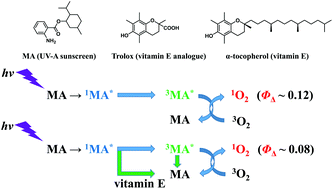Suppression of menthyl anthranilate (UV-A sunscreen)-sensitized singlet oxygen generation by Trolox and α-tocopherol†
Abstract
Menthyl anthranilate (MA, tradename meradimate) is a UV-A absorber. The interactions of ground-state molecular oxygen with the long-lived triplet state of MA produce singlet oxygen through energy transfer. The quantum yield of singlet oxygen generation is 0.12 in air-saturated ethanol. Kinetic traces of the near-IR phosphorescence of singlet oxygen generated by MA-photosensitization have been measured in the absence and presence of Trolox (a water-soluble analogue of vitamin E and a quencher of singlet oxygen) and α-tocopherol (vitamin E, a natural antioxidant) in ethanol. Fluorescence and transient absorption measurements suggest that Trolox and α-tocopherol quench the lowest excited singlet and triplet states of MA. As a result, Trolox and α-tocopherol suppress MA-photosensitized singlet oxygen generation. Not only the quenching of singlet oxygen but also the suppression of singlet oxygen generation is the mechanism of antioxidant properties of Trolox and α-tocopherol for MA. The ability of α-tocopherol to suppress the MA-photosensitized singlet oxygen generation in isododecane, used as a solvent for an oil-soluble UV absorber, is close to that in ethanol. Suppression of sunscreen-photosensitized singlet oxygen generation is an important method for the formulation of safe cosmetic sunscreens.



 Please wait while we load your content...
Please wait while we load your content...